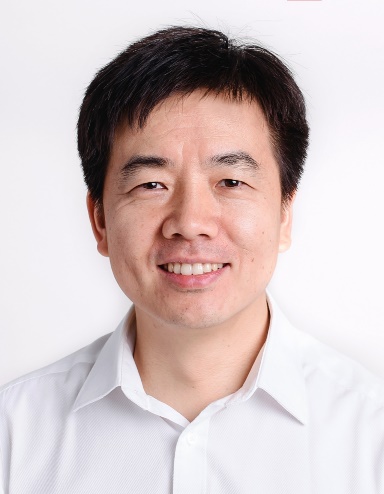报告题目:PerovLight: Perovskite Materials for Emergent Nanophotonics and Polaritonics
报告人:熊启华教授
报告时间:2019年6月6日(星期四)下午2:00
报告地点:长安校区启翔楼233会议室
邀请人:官操教授
承办学院:柔性电子研究院
联系电话:8846-0889
报告摘要:
Halide perovskites have recently attracted tremendous attention due to their remarkable properties as an optical gain material, which have shown high performance in solar cells, light-emitting diodes, photodetectors and many other optoelectronic applications. In this talk, I will first review our recent progress in the investigation of halide perovskite materials as excellent optical gain materials, which can be synthesized by either physical or chemical ways. Steady-state and transient spectroscopy approaches can elaborate the large exciton binding energy higher than room temperature thermal excitation energy, and exciton dynamics. High crystalline quality supports the optically pumped photonic lasing based on the intrinsic whispering gallery mode cavity, while the lasing quality factor can be as high as 5000 in all-inorganic perovskite crystals. Next, I will present our experimental realization of room-temperature polariton lasing in all-inorganic cesium lead chloride perovskite crystals embedded in two distributed Bragg reflectors. The perovskite crystals possess efficient polariton-polariton scattering due to the Wannier-Mott exciton nature with large binding energy. The polariton lasing is evidenced by a superlinear power dependence, macroscopic ground state occupation, and increase of the temporal coherence. Finally, we will present our recent results of manipulating polariton Bose-Einstein condensate in one-dimensional perovskite waveguide and lattices, opening a new venue towards room temperature quantum fluids of light and quantum optics.
Key words:Halide Perovskites, Exciton Polariton, Spontaneous coherence, Polariton Laser, Polariton Bose-Einstein Condensate.
References:
1.R. Suet al., “Room temperature one-dimensional polariton condensate propagation in lead halide perovskites”,Science Advances, DOI: 10.1126/sciadv.aau0244 (2018)
2.K.B. Linet al., “Perovskite light-emitting diodes with external quantum efficiency exceeding 20 per cent”,Nature562, 245-248 (2018)
3.J. Xinget al., “Color-stable highly luminescent sky-blue perovskite light-emitting diodes”Nature Communications, DOI: 10.1038/s41467-018-05909-8 (2018)
4.G.K. Longet al., “Spin control in reduced-dimensional chiral perovskites”,Nature Photonics12, 528-533 (2018)
5.F. Yan,et al., “Highly efficient visible colloidal lead-halide perovskite nanocrystal light-emitting diodes”,Nano Lett.18, 3157-3164 (2018)
6.R. Suet al., “Room temperature polariton lasing in all-inorganic perovskite”,Nano Lett.17, 3982–3988 (2017)
7.Q. Zhang,et al., “High quality whispering-gallery-mode lasing from cesium lead halide perovskite nanoplatelets”,Adv. Funct. Mater. 26, 6238-6245 (2016)
8.Q. Zhang,et al., “Room-temperature near-infrared high-Q perovskite whispering-gallery planar nanolasers”,Nano Lett.14, 5995-6001 (2014)
报告人简介:
 熊启华是南洋理工大学数理科学学院和电气电子工程学院双聘教授。美国物理学会会士。1997年本科毕业于武汉大学物理系,2000年从上海应用物理研究所获得硕士学位,2006年于宾夕法尼亚州立大学获得博士学位,师从Peter C. Eklund教授。2006-2009年在哈佛大学Charles Lieber研究组从事博士后研究。2009年初获得新加坡国立研究基金研究员项目资助并于当年6月加入南洋理工大学,任南洋助理教授。2014年获得终身教职,2016年升正教授。2014-2019年间担任数理科学学院副院长。熊启华教授的主要研究领域是以稳态和瞬态光谱学为主要实验手段,以光和物质相互作用为研究主题,着重研究低维半导体纳米材料基于光子-声子-电子耦合作用的物理机制和量子调控。他在纳米光子学和表面等离子体学,激光制冷,以及二维半导体材料光学性质等一系列前沿课题做出了一系列有影响的工作。在《自然》及子刊,《科学-进展》,《纳米通讯》,《先进材料》等一系列国际知名杂志上发表了200多篇文章,并被世界知名杂志及大众媒体所报道,总引用次数超过10000次,H-因子59。其出色的研究获得了一些奖励和认可,比如新加坡物理学会纳米科技奖(2015),新加坡国立研究基金NRF Investigatorship奖(2014),和南洋理工大学南洋研究卓越奖(2014)等。2018年4月起,担任美国光学学会旗舰杂志《Optics Express》副主编。2018年12月起,担任Wiley信息材料领域新创刊杂志《InfoMat》的副主编。
熊启华是南洋理工大学数理科学学院和电气电子工程学院双聘教授。美国物理学会会士。1997年本科毕业于武汉大学物理系,2000年从上海应用物理研究所获得硕士学位,2006年于宾夕法尼亚州立大学获得博士学位,师从Peter C. Eklund教授。2006-2009年在哈佛大学Charles Lieber研究组从事博士后研究。2009年初获得新加坡国立研究基金研究员项目资助并于当年6月加入南洋理工大学,任南洋助理教授。2014年获得终身教职,2016年升正教授。2014-2019年间担任数理科学学院副院长。熊启华教授的主要研究领域是以稳态和瞬态光谱学为主要实验手段,以光和物质相互作用为研究主题,着重研究低维半导体纳米材料基于光子-声子-电子耦合作用的物理机制和量子调控。他在纳米光子学和表面等离子体学,激光制冷,以及二维半导体材料光学性质等一系列前沿课题做出了一系列有影响的工作。在《自然》及子刊,《科学-进展》,《纳米通讯》,《先进材料》等一系列国际知名杂志上发表了200多篇文章,并被世界知名杂志及大众媒体所报道,总引用次数超过10000次,H-因子59。其出色的研究获得了一些奖励和认可,比如新加坡物理学会纳米科技奖(2015),新加坡国立研究基金NRF Investigatorship奖(2014),和南洋理工大学南洋研究卓越奖(2014)等。2018年4月起,担任美国光学学会旗舰杂志《Optics Express》副主编。2018年12月起,担任Wiley信息材料领域新创刊杂志《InfoMat》的副主编。